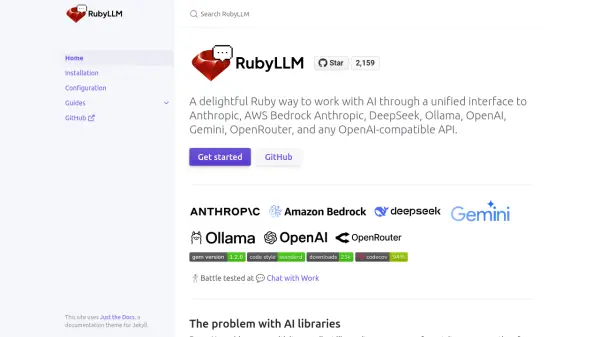What is RubyLLM?
RubyLLM addresses the challenge of integrating multiple Artificial Intelligence (AI) providers into Ruby applications. Different AI services often come with unique client libraries, response formats, streaming conventions, and error handling methods, leading to complex and bloated codebases when using more than one provider. RubyLLM provides a single, streamlined API to interact with various AI models, including those from Anthropic, AWS Bedrock Anthropic, DeepSeek, Ollama, OpenAI, Gemini, OpenRouter, and any OpenAI-compatible API.
This library simplifies common AI tasks by offering a consistent interface and minimal dependencies. Key functionalities include initiating chats with AI models, analyzing images and audio files, summarizing PDF documents, generating images, and creating text embeddings for vector search. It also supports function calling, allowing AI models to execute custom Ruby code, and offers seamless integration with Ruby on Rails for persisting chat data. Responses can be processed in real-time using idiomatic Ruby blocks for streaming.
Features
- Unified Chat: Converse with models from OpenAI, Anthropic, Gemini, Bedrock, OpenRouter, DeepSeek, Ollama, or any OpenAI-compatible API using a single interface.
- Vision Analysis: Analyze images provided within chat contexts.
- Audio Analysis: Transcribe and understand audio content.
- PDF Analysis: Extract information and summarize PDF documents.
- Image Generation: Create images programmatically.
- Embeddings Generation: Generate text embeddings suitable for vector search applications.
- Tools (Function Calling): Enable AI models to invoke and utilize custom Ruby code.
- Rails Integration: Easily persist chats, messages, and tool calls within Ruby on Rails applications using provided helpers (acts_as_chat, acts_as_message).
- Streaming Responses: Process AI model responses in real-time using standard Ruby blocks.
Use Cases
- Developing AI-powered chatbots within Ruby applications.
- Integrating image analysis capabilities into Ruby projects.
- Adding audio processing and transcription features to Ruby applications.
- Building tools to summarize or extract data from PDF documents using Ruby.
- Generating images programmatically as part of a Ruby application workflow.
- Implementing semantic search or recommendation systems using text embeddings in Ruby.
- Creating AI agents capable of interacting with external systems via Ruby code.
- Simplifying the integration of multiple AI providers in Ruby on Rails projects.
Related Queries
Helpful for people in the following professions
Featured Tools
Join Our Newsletter
Stay updated with the latest AI tools, news, and offers by subscribing to our weekly newsletter.











